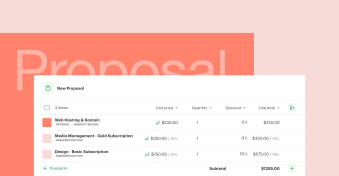Creating an effective outbound sales strategy for your team can be a tricky proposition.
Cold, impersonal outreach won’t win points with customers — and that’s assuming that it even reaches their inbox at all. Instead, you’ll have to take a more targeted approach to earn leads with outbound strategies.
But just because the days of cold calling and big email blasts are mostly gone doesn’t mean that the outbound sales process is dead.
Here are four great methods to boost your ROI when using outbound sales techniques.
Outbound sales vs. outside sales
Before we jump in, let’s take a quick moment to set a few ground rules and definitions.
This article refers specifically to outbound sales, which is often confused with outside sales. To clear this up:
- Outbound sales refers to the process of reaching out to prospects who haven’t indicated a direct interest in buying the product or service you want to sell. This is the opposite of inbound sales, where the prospect comes to you by volunteering their information (filling out a form, requesting a demo, etc.) with the intent to purchase.
- Outside sales refers to the process of sending an actual salesperson into the field to meet with prospective customers. Sales are usually conducted through face-to-face meetings, at conferences and trade fairs, and similar events.
These terms are pretty easy to confuse, so it’s worth clearing the air before you jump in.
Now, with that out of the way, let’s get started.
Method 1: Engage in social selling
Social selling leverages social networks like LinkedIn and Instagram to connect with potential customers outside of more traditional forms of contact.
For outbound sales teams, social media is a great tool to boost lead generation and accelerate your sales cycle.
The features built into advanced targeting tools like LinkedIn Sales Navigator can help you find contact information for key decision-makers and figure out how best to target them.
The power of social selling is relationship-based. As LinkedIn reports:

A referral like this comes with some measure of social proof that sales reps can leverage into a qualified lead.
But social selling is about more than just blasting people with cold outreach and hoping for a response. It has to be combined with other strategies, like content marketing, to be truly effective.
This is where most attempts at social selling get it wrong.
Strong social profiles are active and engaged in the community they intend to target. They create content that addresses the pain points of their target market.
They might comment, follow up on conversations, or provide advice that directly assists customers who fit their ideal customer profile. But they aren’t actually selling!
Because trust and authority are built over time, savvy social users focus on building relationships that eventually lead to a sales call and a closed deal.
This (and other techniques) results in high-quality lead generation, but it’s a long-term strategy that requires active engagement and nurturing from your sales team.
Method 2: Target your email list
Any marketing team worth their salt knows about the value of email marketing.
Email is delivered directly to your prospect’s inbox without passing through a middleman like a social media company. While that might not sound significant, think it over.
People often hold onto email addresses for years — sometimes decades. And email is still around, despite numerous attempts to replace it.
Meanwhile, interest in social media fluctuates. When the next big Facebook or Instagram comes along, you’ll need to rebuild your marketing apparatus all over again on that new platform.
So, why does all of this matter for outbound sales?
Because, if your marketing team already has a healthy and segmented email list, it’s much easier to leverage that tool for your outbound sales strategy.
For the most part, marketers are focused on providing quality content that keeps users engaged. Strong marketing also builds relationships and raises brand awareness, but the messaging is broad.
An effective sales rep can come into play by injecting themselves into the outreach process in a very personal and strategic way.
By cross-referencing email addresses with CRM tools (something that can be easily automated), it’s possible to find decision-makers who are subscribed to your email list but haven’t already purchased your product or service.
From there, the rep can qualify the lead and reach out with an appropriate sales pitch or reject the lead and move on.
This is a simple way to get in touch with potential customers who already have some level of brand awareness and use that familiarity to get a foot in the door.
If done correctly, reps may be able to push users farther down the funnel by helping them draw connections between product features and existing pain points.
Keep in mind, though: this approach should be done on a per-lead basis and kept very personal.
Reps using this technique don’t need big, flashy emails. They need to write short and simple outreach that doesn’t overcomplicate the opportunity.
For reference, Boomerang points out that:

These emails aren’t part of a standard email campaign. Instead, this is personalized outreach that should be targeted to the individual or marketing segment in order to maximize conversion rates.
It’s possible to build an outreach plan around this and still send personalized emails that work. If you have that knowledge on your outbound team, leverage it to close deals using the leads from your existing marketing apparatus.
Method 3: Automate, but stay personal (and not pushy)
No matter what outbound sales campaign you decide to run, automation is crucial to reaching out to as many people as possible.
Unfortunately, it’s easy to get this wrong by relying too heavily on impersonal automation tools like form emails and standardized or templated responses.
And don’t get us wrong: At PandaDoc, we love templates and automated tools — but it’s easy for sales professionals to get so focused on numbers that they end up automating the most important parts of the job. That’s especially true when chasing metrics.
Consider this example: If you’re measuring the success of your outbound strategy or sales prospecting by the number of individuals a rep reaches out to each week, you may find your reps automating outreach in order to meet that quota.
While sending emails and reaching out through social media may help to reach the assigned metric, that doesn’t necessarily equate to an increase in sales or closed deals.
Instead, automate workflows and menial tasks that are better done by computerized tools.
Lead generation tools can help you find leads, source phone numbers, and consolidate information into your CRM based on a pre-selected set of parameters.
Document generation tools, like PandaDoc, can help you quickly create sales documents and contracts that push a deal forward.
At the end of the day, you shouldn’t have an automated system that runs itself. The automation tools you use should cut through the tedium so that your reps can spend more time adding a human touch.
That way, they’ll be better able to connect with prospects and lead them down the sales funnel.
Method 4: Soften your approach
We’ve said it once, but it bears repeating: Faceless and impersonal tactics have no part in a modern outbound sales strategy.
Cold calls and spammy email techniques, while tempting, are more likely to land your phone number on a blocklist or have your email land in the spam box.
However, softening your approach also goes beyond that.
Customers are very aware of the information that companies collect about them.
According to Salesforce, about 80% of customers are willing to share relevant information about themselves in exchange for contextualized interactions in which they’re immediately known and understood.
With that in mind, customers know that you have their information, but your outreach still needs to make sense from the perspective of customer logic.
Inbound sales teams have an advantage here because customers coming in through the inbound channel have volunteered their information and are waiting to be contacted.
For outbound sales, this is the biggest hurdle. Part of your sales tactic needs to focus on explaining why you’re contacting a specific customer at a specific time.
If done incorrectly, this can come across as spammy or creepy. Customers don’t necessarily want to be contacted just because your software tools tracked their IP address when they visited your website.
From the customer’s point of view, a random message from your sales team will feel out of place.
However, if customers are openly voicing concerns or you have a solid, logical argument for getting in touch, then your team can leverage those buying signals to convert deals in real-time.
PandaDoc: your secret weapon for outbound sales docs
While outbound sales strategies are still effective, the best strategy can generate more problems for itself. When your reps have more leads than they can handle, you probably don’t want them spending too much time creating paperwork.
Even when documentation is necessary, slowing down the sales process to work up a contract or build a proposal can leave money on the table.
That’s where automation tools like PandaDoc can help. Our platform consolidates all the tools you need for document generation in one place.
You can create templates, import contacts directly from your CRM, and plug them into contracts and invoices made using PandaDoc to build documents in record time.
And it doesn’t stop there. PandaDoc can help with electronic signature capture, contract lifecycle management, and much more.
Sign up for a free 14-day trial to see how PandaDoc can accelerate your outbound sales process and close deals fast.
Frequently asked questions
-
No, but they are two sides of the same coin.
Marketing techniques are primarily focused on raising brand awareness and trying to get customers to voluntarily enter the top of the funnel as an inbound lead.
That’s often the entire point of content marketing and SEO. These content generation techniques eventually lead to leads that the inbound team can convert to sales.
However, that doesn’t necessarily mean that outbound sales are left out in the cold. Outbound sales teams can use marketing content as sales collateral to leverage brand authority while selling to customers.
-
While outbound sales techniques aren’t inherently worse, they can be quite different.
With inbound sales, customers self-identify and contact the company directly. With outbound sales, reps need to make contact with leads who are inherently less engaged and work to build a rapport.
In some ways, the outreach mindset comes with an advantage because outbound reps are targeting individuals who might not fully understand the value of a product or service and, because of that knowledge gap, would never become an inbound lead.
-
For the most part, these techniques have gone the way of the dodo. As a reference point, this Harvard Business Review article cites a report from over a decade ago pointing out that 90% of people weren’t responding to cold emails even then.
But that’s not to say that outbound sales are dead. Outbound reps can still connect with a target audience or a specific market segment. They can still effectively sell products — but spammy sales tactics won’t get the job done.
Instead, reps need to build rapport, focus on relationships, and choose their moments carefully. In other words, it’s not about how many messages and voicemails you leave; it’s about making sure that you’re addressing pain points and helping the prospect better understand how your product or service solves their needs.
-
It’s absolutely possible.
This problem mostly occurs when sales teams decide to over-automate their lead generation and outreach efforts. While it’s true that reps should use tools to narrow their target audience and consolidate information, outreach still needs to feel natural and intuitive rather than creepy and weird.
Social selling and other relation-based techniques that can close the gap between the rep and the lead prior to initiating contact can help make leads more receptive to outreach by filling gaps in their own logic.
But, overall, these techniques are designed to help reps close that gap so that the initial outreach isn’t as jarring.
Ultimately, that’s the key.
Even if customers aren’t interested in what the company is trying to sell, if reps are generating personalized email that is both timely and non-invasive (from the customer’s perspective), then it won’t come across as spam.


